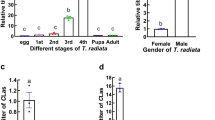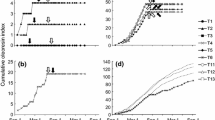Abstract
This study was initiated after pod-boring beetles (Coleoptera: Scolytidae and Nitidulidae) were seen to preferentially colonise cocoa pod lesions caused by Phytophthora palmivora. We hypothesised that these beetles, which colonise discarded pod cases and infected pods, are an important and previously unrecognised vector of the black pod pathogen, P. palmivora, in cocoa plantations. Beetles colonise lesions within 24 h of their appearance, and the number of holes increases as the lesion expands. Beetles captured from naturally infected pod lesions carry viable pathogen propagules on their bodies. Frass residues on the surface of infected, colonised pods are rich in viable pathogen propagules. Contact insecticides significantly reduce both the number of beetle holes and the number of black pod lesions developing on pods, both in the field and under experimental conditions that exclude all sources of inoculum other than that carried by flying beetles. Beetles are attracted to disease lesions and rapidly generate and disseminate secondary inoculum in epidemics of pod rot, and their role must be included in any integrated disease management strategy.
Similar content being viewed by others
References
Anon. (1992). ‘Information Bulletins 1–10.’ (PNG Cocoa & Coconut Research Institute: Rabul, PNG)
Dade HA (1927) Economic significance of cocoa pod diseases and factors determining their incidence and controls. Bulletin of the Department of Agriculture. Gold Coast 6, 1–58.
Dennis JJC, Konam JK (1994) Phytophthorapalmivora cultural control methods and their relationship to disease epidemiology on cocoa in Papua New Guinea. In ‘Proceedings of the 11th international cocoa research conference’. 18–24 July 1993, Yamoussoukro, Cote d′Ivoire, West Africa, pp. 953–957. (Cocoa Producers Alliance: Lagos, Nigeria)
Dennis JJC, Prior J, Saul YJ, Konam JK (1995) Comparative observations on control of some pests and diseases of cocoa common to Indonesia, Malaysia and Papua New Guinea. Cocoa Growers Bulletin 49, 41–51.
Evans HC (1973) New developments in black pod epidemiology. Cocoa Growers Bulletin 20, 10–16.
Gregory PH (1974) Prospects. In ‘Phytophthora disease of cocoa’. (Ed. PH Gregory) pp. 301–308. (Longman Group Ltd: London)
Gregory PH, Griffin MJ, Maddison AC, Ward MR (1985) Cocoa black pod: a reinterpretation. The Planter 61, 195–197.
Holderness M (1992) Biology and control of Phytophthora diseases of cocoa in Papua New Guinea. In ‘Cocoa pest and disease management in South East Asia and Australasia’. FAO Plant Production and Protection Paper 112. (Eds PJ Keane, CA Putter) pp. 171–184. (FAO: Rome)
Keane PJ (1992) Diseases and pests of cocoa. In ‘Cocoa pest and disease management in South East Asia and Australasia’. FAO Plant Production and Protection Paper 112. (Eds PJ Keane, CA Putter) pp. 1–11. (FAO: Rome)
Konam JK (1992) The epidemiology of Phytophthora palmivora diseases of cocoa in the soil in Papua New Guinea. PGDSci Thesis, University of Papua New Guinea.
Konam JK (1999) Integrated management of Phytophthora palmivora diseases of cocoa in Papua New Guinea. PhD Thesis, The University of Melbourne, Melbourne.
Maddison AC, Ward MR (1981) The international black pod project: 1979 review. In ‘Proceedings of the 7th international cocoa research conference’. 4–12 November 1979, Douala, Cameroun, pp. 261–266. (Cocoa Producers Alliance: Lagos, Nigeria)
Masago H, Yoshikawa M, Fukada M, Nakanishi N (1977) Selective inhibition of Pythium spp. on a medium for direct isolation of Phytophthora spp. from soils and plants. Phytopathology 67, 425–128.
Medeiros AG (1976) Sporulation of Phytophthora palmivora (Butl.) in relation to epidemiology and chemical control of cacao black pod disease. PhD Thesis, University of California, Riverside.
Newhall AG, Daiz F, Salazar (1966) Results of some soil treatments on black pod rot of cacao caused by Phytophthora palmivora. Cacao 11, 10–12.
Okaisabor EK (1971) Insect transmission and the control of Phytophthora pod rot disease by insecticides. Premiere Reunion S/Groupe Trav. Africuesur Phytophthora palmivora, Yaund ’e, 1971.
Okaisabor EK (1974) Phytophthora pod rot infection from the soil. In ‘Phytophthora disease of cocoa’. (Ed. PH Gregory) pp. 161–168. (Longman Group Ltd: London)
Turner PD (1965) Behaviour of Phytophthora palmivora in soil. Plant Disease Reporter 49, 135–137.
Webber JF, Gibbs JN (1989) Insect dissemination of fungal pathogens of trees. In ‘Insect-fungus interactions’. (Eds N Wilding, NM Collins, PM Hammond, JF Webber) pp. 161–194. (Academic Press: London)
Author information
Authors and Affiliations
Corresponding author
Rights and permissions
About this article
Cite this article
Konam, J.K., Guest, D.I. Role of beetles (Coleoptera: Scolytidae and Nitidulidae) in the spread of Phytophthora palmivora pod rot of cocoa in Papua New Guinea. Australasian Plant Pathology 33, 55–59 (2004). https://doi.org/10.1071/AP03082
Received:
Accepted:
Issue Date:
DOI: https://doi.org/10.1071/AP03082




